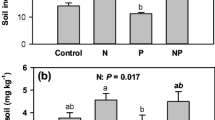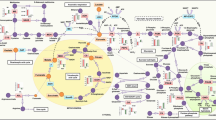Abstract
This paper briefly reviews pathways by which plants can influence the nutrient cycle, and thereby the nutrient supply of themselves and of their competitors. Higher or lower internal nutrient use efficiency positively feeds back into the nutrient cycle, and helps to increase or decrease soil fertility. These tendencies are further enhanced by secondary effects (higher or lower rates of decomposition of litter and hence of nutrient mineralization) in resp. fertile and infertile soils. Such feedbacks may strongly increase the fitness of the plants involved. Plants can also influence the external inputs and outputs into the plant-soil system, by affecting the general hydrology of their environment. Sphagnum peat bogs exemplify an extreme degree of control of plants over the hydrological cycle, causing intense nutrient impoverishment by making the ecosystem dependent on nutrient supply from the atmosphere, apparently giving Sphagnum a competitive edge over other plants.
Similar content being viewed by others
References
Berendse F 1990 Organic matter accumulation and nitrogen mineralization during secondary succession in heathland ecosystems. J. Ecol. 78, 413–427.
Berendse F 1994 Litter decomposability — a neglected component of plant fitness. J. Ecol 82, 187–190.
Berendse F and Elberse W Th 1990 Competition and nutrient availability in heathland and grassland ecosystems. In Perspectives on Plant Competition. Eds. DTilman and J BGrace. pp 93–115. Academic press, San Diego.
Boettcher S E 1990 Single-tree influence on soil properties in the mountains of eastern Kentucky. Ecology 71, 1365–1372.
Brown A H F 1992 Functioning of mixed-species stands at Gisburn, N W England. In The Ecology of Mixed Species Stands of Trees. Eds. G RCannell, D CMalcolm and ARobertson. pp 125–150. Blackwell Scientific Publications, Oxford.
Chapin F S III 1991 Effects of multiple environmental stresses on nutrient availability and Use. In Response of Plants to Multiple Stresses. pp 67–88. Ed Academic Press Inc., San Diego.
Dinkelaker B, Römheld V and Marschner H 1989 Citric acid extraction and precipitation of calcium citrate in the rizhosphere of white lupin (Lupinus albus L.) Plant Cell Environ. 12, 285–292.
Dokuchaev V V 1879 A bridged historical account and critical examination of the principal soil classifications existing. Trans Petersburg Soc. Nat. 10, 64–67 (In Russian).
Flanagan P W and VanCleve K 1983 Nutrient cycling in relation to decomposition and organic matter quality in taiga ecosystems. Can. J. For. Res. 13, 795–817.
Hobbie S E 1992 Effects of plant species on nutrient cycling. Tree 7, 336–339.
Hoffland E, Findenegg G R and Nelemans J A 1989 Solubilization of rock phosphate by rape. II Local root exudation of organic acids as a response to P starvation. Plant and Soil 113, 161–165.
Johnson L C and Damman A W H 1991 Species-controlled Sphagnum decay on a south swedish raised bog. Oikos 61, 234–242.
Moore P D and Bellamy D J 1974 Peatlands. Springer, New York. 221 p.
Kilham P 1982 The biogeochemistry of eog ecosystems and the chemical ecology of Sphagnum The Michigan Botanist 21, 159–168.
Pastor J, Aber J D, McClaugherty A and Melillo J M 1984 Aboveground production and N and P cycling along a nitrogen mineralization gradient on Blackhaw Island, Wisconsin. Ecology 65, 256–268.
Tilman D 1988 Plant strategies and the dynamics and structure of plant communities. Monographs in population biology, nr26. Princeton University Press, Princeton, New Jersey. 360 p.
Unestam T 1991 Water repellency, mat formation, and leaf-stimulated growth of some ectomycorrhizal fungi. Mycorrhiza 1, 13–20.
VanBreemen N 1993 Soils asbiotic constructs favouring net primary productivity. Geoderma 57, 183–212.
Wallis M G and Horne D J 1992 Soil water repellency. In Advances in Soil Science, Vol 2. Ed. B AStewart. pp 92–146. Springer-Verlag, New York.
Zinke P J 1962 The pattern of influence of individual trees on soil properties. Ecology 43, 130–133.
Author information
Authors and Affiliations
Rights and permissions
About this article
Cite this article
van Breemen, N. Nutrient cycling strategies. Plant Soil 168, 321–326 (1995). https://doi.org/10.1007/BF00029344
Issue Date:
DOI: https://doi.org/10.1007/BF00029344




